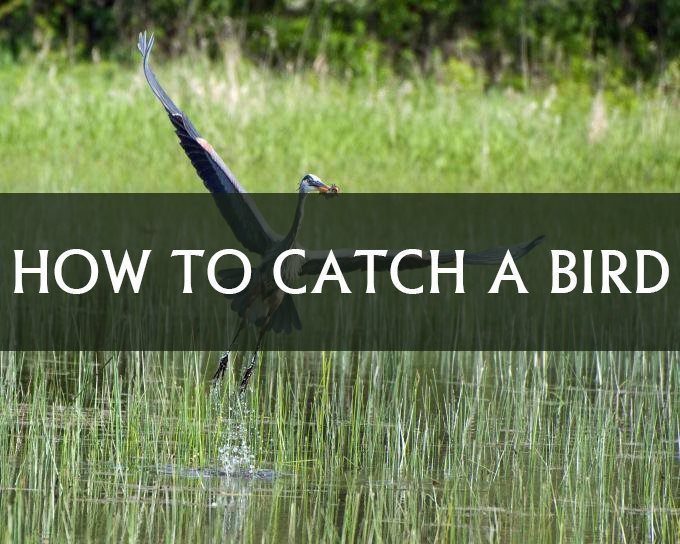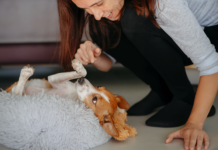Last Updated on February 23, 2023 by
When you were a young kid, curious and adventurous, you probably entertained the imagination; how can I catch a bird in my backyard? You probably thought of having a wild bird as a pet, kept in a cage of some sort, but as you grew older, bird catching was done for other purposes, which included preventing them from being a nuisance on your property. In this article, you’ll learn about how to catch a bird.
Birds can eat fruits, corn, legumes, and other crops in the garden or farm field. They will eat seedlings, tomatoes, and berries. Carnivorous birds like eagles, hawks, ospreys, ravens, puffins, owls, herons, and egrets can raid your outdoor koi pond. Birds are also known to build nests in roof gutters, eaves, trees, tower lights, and other elevated structures, making the place look unsightly and abandoned. Woodpeckers can cause damage to your timber walls and trees.
Table of Contents
Different ideas on how to catch a bird:

Look both up and down:
Birds can be hard to find because they’re small enough to hide under many household items, but they can also fly up out of your vision. Finding them could require that you do some extensive searching. Start by verifying that they are not in any dangerous place.
- Dangerous hideouts include water glasses, bathrooms, doorways, windows, stoves, and sofas. Hard-to-find hideouts include curtain rods, plants, lamps, mantels, ceiling fans, picture frames, and underneath furniture. They can also hide inside objects like laundry baskets, boxes, and drawers.
Stay cool:
Birds understand body language, so screaming or frantic movements will cause them to be as anxious as you are. You should speak softly and move at an average pace to ease your nerves.
Make the cage inviting:
Your bird will be more likely to fly back to its cage if it likes being there. The cage should be someplace near where people congregate so that it stays interesting, but it should also be away from windows, which birds believe leave them susceptible to danger. Have a variety of toys in the cage to make it interesting. Finally, give your bird a special treat whenever it goes into the cage.
Please do not give the bird the same treat on any occasion other than returning to the cage, or it might find going back to the cageless special. Never use time in the cage as punishment; this will create negative associations with the cage.
Call to your bird as he is flying away:
If you are there when your bird flies away, call after him using a calm but loud voice. If he realizes he is suddenly in the wild and doesn’t want to be, he will be able to immediately make his way home following the sound of your voice. Seeing his cage might inspire your bird to fly down to you immediately, as this is a familiar object in a very unfamiliar world.
Keep your eyes on your bird:
Chances are your bird will not fly terribly far away, as birds that spend most of their time in their cages tend not to be such strong flyers. Please keep your eyes on it until it is out of sight. Pay attention to how low it was flying and how tired it looked; these indicate that it may have landed just out of your vision.
Bring another pet bird with you:
If you have another pet bird that your escaped bird gets along with, bring this bird with you in her cage. Place the cage where you can see it. The bird in the cage will likely start calling out to you, which might inspire your lost bird to begin calling. Listen for your escaped bird’s call.
Bring your bird’s favorite toys with you.
To lure your bird into the cage, you should bring its favorite toys and treats. If the bird is particularly fond of one person, try to have them present. All of these items can be used to lure your bird back to you.
Capture it:

If a hose is readily available, spray the bird with large amounts of water for a short period. This will make it heavy so that it cannot fly off. Grab it in a way that will secure it in your hands without applying too much pressure; birds are delicate. If you or your friends lack experience holding a bird, try throwing a pillowcase around it instead.
It is important not to be too gentle with the hose. If you don’t get the bird sufficiently wet quickly enough, it will only be frightened off.
How do you catch a bird indoors?
Use a sheet rather than a towel if you cannot catch the bird. A heavy towel may exert too much pressure and cause the bird an injury. If you have no option but to handle a bird, use gloves or a sheet between the bare skin and the feathers.
Latest information
In 2023, Mandai Wildlife Group plans to open a new bird park. Upon Jurong Bird Park’s closure on January 3, this iconic experience will take place. More than 3,000 birds from 400 avian species will be housed in Bird Paradise, the new 17-hectare park. Through eight large walk-through aviaries, visitors can get up close and personal with the birds, which are made up of species that live in different biomes across the globe, such as African rainforests, South African wetlands, Southeast Asian paddy fields, and Australian dry eucalyptus forests.
Conclusion:
Have friends scattered around to watch what direction the bird flies if it escapes? Even better if they can find a high perch for a good view. How to catch a bird? Nighttime can be a good time to catch a bird. They often are tired. Furthermore, if you shine a high-powered flashlight in their face, they might be blinded long enough for another person to grab them.
Apart from this, if you are interested to know about How To Create A Foyer In An Open Living Room, then visit our lifestyle category.
Frequently Asked Questions
The birds will eventually eat near your hand; on a day when the feeder is getting low or is empty (or you can even take the feed out temporarily), place nuts and seeds in the palm of your hand and wait patiently for a taker. Once a bird lands on your hand, stay still and quiet.
We can estimate that a typical bird, with 10% of its body weight being composed of fat, will survive 1 to 3 days.
. The bird is either sick or injured.






















